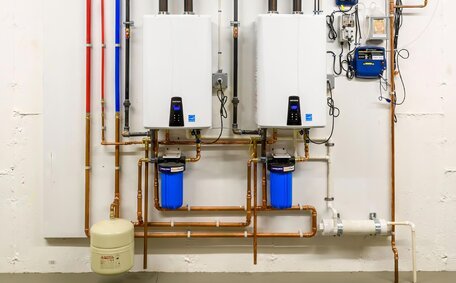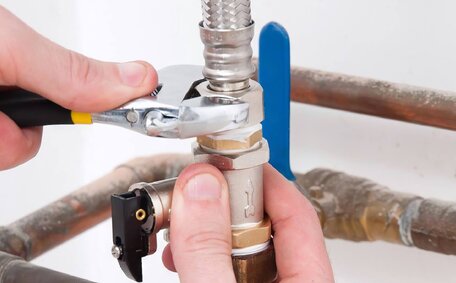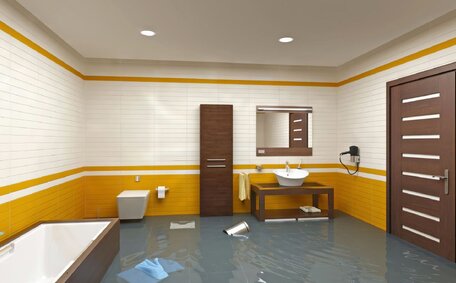Introduction: Why You Need a Home Plumbing Toolkit
Being prepared for plumbing emergencies is essential for every homeowner. Having the essential plumbing tools on hand for addressing common plumbing problems can help avert costly damage and emergencies.
A comprehensive plumbing toolkit must include key items such as a plunger, drain snake, pipe wrench, and pliers—ideal for quickly addressing clogged drains, leaking pipes, and running toilets to maintain your plumbing system.
A well-equipped DIY repair kit empowers you to quickly tighten or loosen connections, proving invaluable when you require immediate plumbing solutions. Stocking tools suited for your home’s plumbing system enables efficient self-managed repairs, which may diminish the need for professional plumbing services.
This guide from the licenced plumbers at Bella Vista Plumbing will provide Sydney homeowners advice on building a toolkit essential for every household. Discover practical advice on specific tools essential for every residence, including their effective use for urgent plumbing repairs.
The Essential Duo: Plungers to Clear Clogs
Equipped with essential tools such as a dual-purpose plunger for toilet and sink blockages, you can effectively address clogs in your home. As plungers may appear alike, it’s crucial to recognise that each type is engineered for specific plumbing systems like toilets and sinks, and using them correctly is paramount.
The flange plunger, with its seal-forming rim, excellently creates suction to clear toilet clogs. Conversely, the flat bottom of a cup plunger makes it perfect for clearing clogs in bathroom and kitchen sinks.
For stubborn clogs, it’s essential to choose the correct plunger type, since using a cup plunger for toilets or a flanged one for sinks will likely lack the necessary force for effective unclogging. Having one of each style plunger ensures you have the right tool ready to vigorously plunge away all types of common household clogs.
Toilet Plungers
A top-quality flange plunger is essential for swiftly handling sudden toilet clogs. Commence the task by ensuring the plunger forges a robust airtight seal around the toilet drain opening, a vital initial step in addressing a plumbing problem. Initially plunge gently to loosen debris before executing around 15 vigorous pumps to create substantial suction within the pipes. A top-quality flange plunger is essential for swiftly handling sudden toilet clogs.
Ensure you repeat the process as needed until the clog clears.
Flange plungers have a key advantage over sink plungers for tackling toilet blockages, but sometimes a plumbing snake is required for more stubborn issues. Restricting airflow maximises suction for more effective plunging.
Whilst a plunger stands as an effective initial defence against minor toilet clogs, summon a licenced plumber without delay if repeated attempts prove futile. For severe blockages, the mechanical power of a drain snake, operated by a licensed plumber, might be essential to fully restore water pressure.
Sink Plungers
Sink plungers, with the assistance of plumbers tape teflon, are vital for clearing clogs in bathroom and kitchen sinks, providing an effective seal for your repair tasks. The key difference from a toilet plunger is the flat bottomed cup design that generates robust suction. When used correctly over a sink drain, vigorous plunging forces water down to dislodge debris.
Begin by filling the sink halfway, then firmly place the plunger over the drain hole to ensure a tight seal before commencing. Plunge rapidly up and down 15-20 times, give the plunger a slight twist to re-establish the seal, and repeat as necessary to dislodge the obstruction.
A quality sink plunger is invaluable for quickly resolving bathroom and kitchen sink clogs, potentially saving on expensive plumbing fees. It allows you to quickly address issues before they have a chance to cause water damage or overflow. Be sure to store it within easy reach under sinks so it’s always there when you need it.
Wrenches for Pipes and Fixtures
Pipe wrenches, essential for both professionals and DIY enthusiasts, come into play when servicing water heaters and securing pipe fittings. Their jaw-like design grips rounded surfaces effortlessly, ideal for securing threaded connections. Drain cleaners complement plungers by offering solutions for more persistent drainage issues.
Adjustable wrenches enhance your toolkit’s versatility, facilitating easy adjustments to pipe fittings. Their adjustable jaws enable one tool to fit nuts and bolts of various sizes, accommodating most fasteners. Having an adjustable wrench ensures you can manage minor repairs, like twisting or securing pipes and fittings of differing sizes.
Possessing both types of wrenches empowers homeowners to promptly address common leaks or problems. Tightening a loose sink connection or securing an unstable toilet base prevents small problems from escalating into disasters.
Pipe Wrenches
Pipe wrenches, sometimes called Stillson wrenches, are superior plumbing tools used for gripping and turning pipes fittings. The curved jaw design provides superior leverage and grip and can be used effectively on especially rounded surfaces.
When using a pipe wrench, position the jaws so they grip the pipe with the handle facing the direction you want to turn. Pull the handle in a slow, steady motion to avoid damage. Take care not to over-tighten pipes as this can cause cracks or breakage.
Alongside a strap wrench, pipe wrenches are available in different sizes, servicing everything from petite sink supply lines to expansive main water lines. They empower homeowners to complete various pipe tasks, and become a key component of your DIY repertoire, such as tightening compression fittings, connecting valves or sealing threaded pipes with just one versatile tool.
Adjustable Wrenches
A wrench adjustable to various nut sizes is an essential, versatile tool that every homeowner should have on hand. With adjustable jaws, one wrench can grip and turn a wide range of bolt and nut sizes, allowing you to tackle minor repairs on plumbing pipes, valves, fittings, and more with the right tools in hand.
Use an adjustable wrench by clamping it over the nut or bolt and secure the handle firmly for the necessary adjustments. Adjustable wrenches come in various sizes - select a 12-inch wrench for light tasks or a larger 15-inch size for leverage on stuck plumbing connections.
Employ a slow, reliable pulling action on the handle to loosen or tighten as required with these essential tools aiding your maintenance efforts.
With an adjustable wrench and plumber’s putty at the ready, you can swiftly manage minor leaks and help prevent costly plumbing emergencies. They allow homeowners to quickly stop drips, tighten loose parts, secure unstable toilets or sinks, and complete other urgent fixes during plumbing mishaps.
Basin Wrenches
Basin wrenches are among the tools every homeowner should find handy for accessing tightly spaced areas under sinks and behind toilets. They feature a long handle with adjustable jaws at the end to grip nuts and bolts. This facilitates watertight adjustments even in confined spaces.
The key advantage of basin wrenches is the ability to twist connections that would otherwise be unreachable. Trying to fit your hand with a standard wrench is difficult under bathroom and kitchen sinks. Basin wrenches offer the perfect solution for those hard-to-reach tasks.
To use a basin wrench, insert the jaws over the nut and fasten into place. Carefully twist the wrench handle for tightening loosening as required. Having one on hand lets homeowners nip pipe leaks in hard-to-access spots in the bud before major issues occur.
Other Helpful Tools
While plungers, wrenches, and snakes make up the core of any homeowner’s toolkit, having additional tools on hand provides versatility for other plumbing tasks.
A hand auger is a specialised tool effective for clearing clogs in sink, shower, and tub drains that are too deep for regular plungers to reach. A pipe cutter allows for accurate adjustments like trimming supply lines, while Teflon tape reinforces connection seals.
Plumber’s tape, or PTFE tape, is crucial for creating leak-proof seals on threaded pipe connections in toilets and sinks. For increased longevity, wrap the threads of pipes connecting toilets and sinks with 2-3 overlapping layers of Teflon tape prior to installation.
Here some items you’ll find invaluable: rubber gloves for protection, duct tape for temporary repairs, a caulking gun for sealing, and a utility knife for precise cutting. Having this well-stocked inventory empowers homeowners to tackle plumbing mishaps head-on.
Drain Snakes
Drain snakes, also known as plumbers snake, are essential tools for tackling more stubborn clogs and blockages that don’t respond to plunger action. These coil spring rods have a metal cable inside that can be fed down pipes and drains to break up stubborn obstructions.
To use a drain snake, Start by disconnecting pipes under sinks or accessing the drain as you prepare to snake the drain. Slowly feed the metal cable down, turning the handle as you go until you reach the clog. Drain snakes can tackle many plumbing issues, reaching much further than plungers, making them ideal for deep, extensive clogs.
Once there, twist and push the cable to cut through the debris, especially when you need to tackle deep blockages. Retract and remove finding to pull out the dislodged gunk.
Having a quality drain snake on hand saves homeowners from extensive plumbing bills to mechanically clear fully blocked drains. They allow you to remove tough sludge, soap buildup, hair, and other debris that accumulate over time. Be sure to carefully handle the cable to avoid scratching pipes or porcelain.
Teflon Tape
Teflon tape, also known as plumbers tape or PTFE tape, is an essential tool for creating a watertight seal on threaded pipe connections. Properly wrapping pipes with Teflon tape is a great tactic to prevent leaks and ensures a tight seal should your pipes require it.
To use Teflon tape, begin by cutting off a strip in the appropriate width for snugly wrapping around pipe threads. Wrap the tape tightly around the pipe threads 2-3 times to create a watertight seal, being careful not to overly stretch or tear the tape.
Each wrapped layer of tape used should overlap half onto the previous wrap, ensuring a snug seal. This ensures complete coverage without blocking flow when the connections are tighten together.
Having Teflon tape on hand allows homeowners to properly seal pipes for fixtures, valves, adapters and more. It fills tiny spaces between threads that can lead to drips or moisture build up over time. Just be sure not to overdo it on tape layers as too much thickness can prevent proper threading.
Flashlights
Having a durable, waterproof flashlight, alongside tools like a metal file, is vital for any home plumbing toolkit. Dark, cramped spaces like under sinks or inside toilet tanks can be difficult to navigate without proper illumination, making having tools like needle nose pliers for precision work all the more essential. Using a high-powered LED flashlight significantly improves the visibility of pipes, fittings, and blockages, making inspection easier.
Choose a compact and sturdy flashlight for enhanced visibility when working on dim plumbing fixtures. Waterproof models you can use allow you to illuminate wet areas like leaky pipes under sinks without any risk of short circuiting. Useful features to look for include adjustable beam widths for tightening or loosening screws, rapid charges, and magnets or hooks for hands-free operation.
Inspecting plumbing issues with a flashlight allows you to identify problems quickly before major damages occurs. The focused beam lets you look closely at worn washers, loose joints, stuck valves, and lurking clogs. Properly lighting confined work areas also enhances safety, something every homeowner should hand over significant attention to, avoiding slips or accidental bumps into sharp pipes.
Gloves and Protective Gear
Having protective gear in hand can be crucial when tackling plumbing issues or making repairs. Always wear thick rubber gloves when working with pipes to avoid direct contact with water, grime and contaminants. Goggles shield eyes from debris or chemical splashes when augering clogs or handling drain cleaners.
Knee pads provide cushioning and prevent aches when crawling to access confined areas like under sinks for extended periods. A headlamp worn over protective eyewear frees both hands for complex tasks requiring precision in dim, awkward spaces.
Waterproof and non-slip boots with steel toes are essential for stability and safeguarding your feet during plumbing work. Having gloves, goggles, kneepads, and durable footwear helps protect your body from injury during plumbing mishaps.
When to Call a Professional Plumber
While having the right tools allows homeowners to tackle many minor plumbing repair jobs themselves, including those with different types of fittings, it’s wise to recognise when more complex problems require an emergency plumber. Should tireless plunging efforts prove insufficient for a severe blockage or you come across significant pipe damage, it’s time to call us at Bella Vista Plumbing for immediate expert assistance.
A commercial plumber has the skills, equipment, and experience to address tricky situations that your home’s plumbing might present. Augering machines, leak detection devices and drain cameras at their disposal simplify diagnoses and repairs the typical DIYer simply lacks. They can also handle large-scale pipe replacements and remodels efficiently.
In the event of water flooding from burst pipes, it’s imperative to immediately shut off the main valve and call your local emergency plumber. For residents around Bella Vista in northwest Sydney, contact the licenced team at Bella Vista Plumbing on 1300 349 338 for reliable, prompt support day and night.
Quick action with a well-equipped plumbing kit can mitigate significant damage, swiftly containing a plumbing crisis before it leads to extensive structural harm.






